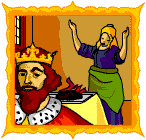Alfred the Great - King of the West Saxons
Created | Updated Nov 3, 2011

Alfred was the youngest son of King Ethelwulf and Osburga, and lived from 849 - 899. His mother died soon after his sister married Burhed, King of Mercia1. Ethelwulf then resigned his kingdom to his eldest son Ethelbald and went on pilgrimage to Rome with the then eight-year-old Alfred.
While in Rome, Alfred was confirmed by Pope Leo IV and on the return trip they stopped at the court of Charles the Bald, King of the Franks who gave his daughter Judith as Ethelwulf's second wife.
After Ethelwulf's death his other sons Ethelbert and Ethelred I ruled. Ethelred was fatally wounded at Merton in 871 while defending his kingdom against Danish invaders. His sons were too young to take over as king, so Alfred succeeded to the throne.
The King Who Burnt the Cakes?
Alfred was crowned at Kingston, Surrey, UK2. During the early part of his reign he continued the fight against the Danes until, in 877, he and his army retired to the Isle of Athelney. This is the period where the two great legends about Alfred come from. The first is that he travelled around disguised as a wandering harpist, gathering information from behind enemy lines. The second is that while hiding in a swineherder's hut he burnt the swineherder's wife's cakes that he had been trusted to watch. Hence Alfred is still known as the King who burnt the cakes.
In May, 878, Alfred led his army to Wiltshire. They faced the Danes at Ethandune (Edington) and victoriously pushed them back to Chippenham. Soon after a treaty known as Danelaw was signed. This was a total withdrawal of the Danes from Wessex in return for East Anglia, Mercia and Northumbria.
Alfred also was responsible for building the first English navy3, encouraging learning and setting up the first Parliament.
There are three great periods of fortification in England, Henry VIII was responsible for the most recent in the 16th Century, the Normans for another in the 12th Century, but Alfred was the first to set up strongholds to defend his territory on a large scale and regimented manner in the 9th Century.
Time
Alfred was also attributed with a fairly accurate way of measuring time. He divided a candle in equal portions of different colour and placed this in a lantern. The lantern was made of thin horn thus allowing the candle and the light to be seen but allowing the air to be regulated thus stopping gusts or the normal passage of wind in the unglazed churches and monasteries, thus allowing the monks to be able to tell the time for morning matins or evening vespers.
He died in 899 and is buried in Hyde Abbey, Winchester. His son Edward the Elder succeeded him.

